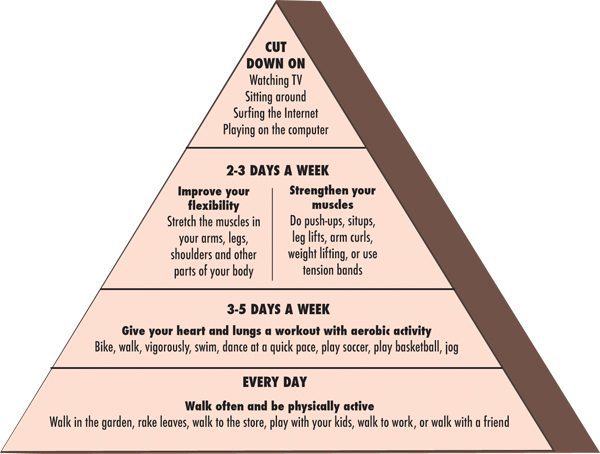By Karl Lenser
The answer to this question lies within an exercise model that is known as the Physical Activity Pyramid. Many of us understand the importance of physical activity and the many benefits that can be derived from structured and unstructured bouts of exercise. Several of these benefits include weight (fat) loss, a higher metabolism, a reduction in blood pressure and cholesterol levels, a reduction in the risk for heart disease and an increase in work capacity and self esteem.
 Many of us understand the importance of physical activity and the many benefits that can be derived from structured and unstructured bouts of exercise. Several of these benefits include weight (fat) loss, a higher metabolism, a reduction in blood pressure and cholesterol levels, a reduction in the risk for heart disease and an increase in work capacity and self esteem.
Many of us understand the importance of physical activity and the many benefits that can be derived from structured and unstructured bouts of exercise. Several of these benefits include weight (fat) loss, a higher metabolism, a reduction in blood pressure and cholesterol levels, a reduction in the risk for heart disease and an increase in work capacity and self esteem.
But how much activity does it take to obtain these benefits? Is a daily walk of 15 minutes going to help my waistline? Will raking leaves and gardening put enough of a dent in my caloric expenditure goal to make a difference in my health? Do I need to lift weights daily or will 2x/week be sufficient to obtain an increase in muscle mass and metabolism?
The answers lie within the Physical Activity Pyramid. Modeled after the Food Pyramid, this model illustrates a variety of activities that are placed on four distinct sections or layers of the pyramid. Each level comes with guidelines or recommendations that address the frequency, intensity and duration of exercise that is specific to each level.
The beauty of this model is that it is specific to individual fitness levels and activity interests. It provides a menu of physical activities that anyone can utilize no matter if they are a rookie to exercise or a well-seasoned fitness enthusiast.
THE PYRAMID
At the base is Level 1 which is considered the base or foundation for the pyramid.
Many of the activities within Level 1 are called “Lifetime Physical Activities” and include things that one would do on a daily basis and are easy to do, yet burn calories. Examples would be raking leaves in the yard, taking stairs instead of the elevator, walking the dog, playing golf (walking the course), fishing and bowling. As people age, they tend to gravitate toward this part of the pyramid because the activities that are within this level are low intensity, easy to do and are simply part of living and carrying on daily activities that require minimal skill and effort.
Level 2 is categorized into two sections with one titled “Active Aerobic Activity” and the other side labeled as “Active Sports and Recreation.” The activities within this level are more intense and structured than Level 1 and may include group exercise classes, jogging, cycling and competitive games such as basketball, racquetball and tennis. Since the intensity is moderate to high in these activities, one can perform these activities on only three days per week to obtain health and fitness benefits.
Level 3 of the Physical Activity Pyramid includes Flexibility and Muscular Strength and Endurance exercises. Flexibility exercises, according to the pyramid guidelines, should be done at least three days per week and the muscular strength and endurance exercises performed at least two times per week. The main thing to remember with strength training is that building muscle tissue will boost your metabolism and will help you with your body shape, body image and daily functionability.
Level 4 is essentially the “Couch Potato” level because it lists video gaming, television viewing and Internet surfing as the main activities. The calorie expenditure in this level is virtually non-existent. Minimize the time you spend at this level.
Not one single activity can “do it all” for your health goals. Try to use activities from levels 1, 2 and 3 for variety and a well-balanced fitness plan.
Something is better than nothing. The main idea is to do what your body will allow you to do and try to keep yourself moving on a regular basis. Movement and motion will improve your health and reduce your risk for chronic diseases.
Plan for success. Preparation and discipline are pivotal in whether or not you readily adopt a healthier lifestyle. Find a workout partner and establish some sort of exercise routine that you can adhere to.
Beyond the pyramid. All physical movement helps you expend calories. Occupational calorie burning can also be included in helping you meet your caloric expenditure goals. Jobs that require walking, lifting and other active tasks help keep your calorie meter running.

